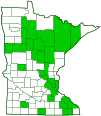Wood Blewit
(Collybia nuda)
Conservation • Description • Habitat • Ecology • Distribution • Taxonomy
|
|
||||||||||||||
Description |
Wood Blewit, often called simply Blewit, is a common and widespread mushroom popular with mushroom foragers. It is found either scattered or growing close together (gregarious) but not in clusters. It often grows in rings or arcs. It obtains its nutrients from decaying organic matter (saprobic). It appears mostly in the cool months from September to December but may appear in spring and summer. When young the cap is purple, smooth, dry, convex, and 1½″ to 5½″ in diameter or larger, and the margins are rolled under. The colors quickly fade away replaced with tan, brown, and flesh color, but the margin often retains some purple coloration. As it ages the cap flattens out and often has a bump in the center. Older specimens sometimes have uplifted, wavy margins. The cap is slippery or greasy to the touch but not slimy when wet and is often somewhat shiny when dry. The gills are closely spaced or crowded and are usually narrowly to broadly attached to the stalk, sometimes with a notch near the stalk, sometimes running down the stalk. They are pale purple or lavender at first and fade to buff, pinkish-buff, or brownish as they mature. The stalk is 1″ to 2¾″ tall or taller and ⅜″ to 1″ or more in diameter at the top. It is sometimes bulbous at the base. It is dry and is covered with fibers or hairs. It is purplish or the same color as the gills when young, becoming brownish as it matures. The base is often covered with purple, downy mycelium. The flesh is purplish to lilac buff or whitish. The spore print is pale pink to pinkish-buff. Wood Blewit is edible. It has a pleasant to slightly bitter taste and an odor, when fresh, that has been compared to frozen orange juice. |
Similar Species |
Habitat and Hosts |
On the ground in deciduous or coniferous woodlands, gardens, and compost piles. |
Ecology |
Season |
September to December |
Distribution |
||
|
Sources Biodiversity occurrence data published by: Minnesota Biodiversity Atlas (accessed through the Minnesota Biodiversity Atlas Portal, bellatlas.umn.edu, 8/14/2025). |
|
| 8/14/2025 | ||
Occurrence |
||
Widespread and very common |
||
Taxonomy |
|
Kingdom |
Fungi (Fungi) |
Subkingdom |
Dikarya |
Phylum |
Basidiomycota (Basidiomycete Fungi) |
Subphylum |
Agaricomycotina (Higher Basidiomycetes) |
Class |
Agaricomycetes (Mushrooms, Bracket Fungi, Puffballs, and Allies) |
Subclass |
Agaricomycetidae |
Order |
|
Suborder |
Tricholomatineae |
Family |
Clitocybaceae |
Genus |
Collybia |
Suibenus |
Leucocalocybe |
Genus Wood Blewit has long been known by two scientific names, reflecting strongly held positions by taxonomists. In 1871 and for the next 100 years Wood Blewit was known by some authors as Trichloma nudum and by others as Lepista nuda. In 1969 Lepista was demoted to a subspecies of Clitocybe. In 2003 it was proposed that the subgenus was not valid, and Wood Blewit was classified by some as Clitocybe nuda and others as Lepista nuda. A genetic study in 2015 showed that Wood Blewit is not closely related to the species on which the genus Lepista was based, the type species. This suggested that the scientific name should be Clitocybe nuda, though the authors of the study declined to make that - or any - recommendation. A more recent phylogenetic and phylogenomic analysis based on molecular DNA and morphological data (Zheng-Mi He et al., 2023) proposed an updated classification of Clitocybaceae. The authors also transferred Lepista nuda to the genus Collybia, subgenus Leucocalocybe. Index Fungorum, MicoBank, and iNaturalist use the name Collybia nuda. GBIF, NatureServe, and Catalogue of Life use the name Lepista nuda. MushroomExpert.com and California Fungi use the name Clitocybe nuda. |
|
Subordinate Taxa |
|
|
|
Synonyms |
|
Agaricus bicolor Agaricus bulbosus Agaricus nudus Agaricus nudus var. aggregatus Agaricus nudus var. allochrous Agaricus nudus var. majus Agaricus nudus var. praticola Agaricus nudus var. sylvaticus Agaricus tyrianthinus Clitocybe nuda Clitocybe tyrianthina Collybia lilacea Collybia lilacea var. distantelamellata Cortinarius bicolor Cortinarius nudus Gyrophila nuda Lepista nuda Lepista nuda var. armeriophila Lepista nuda var. lilacina Lepista nuda var. pruinosa Lepista nuda var. tridentina Lepista nuda var. tucumanensis Lepista nuda var. tyrianthina Lepista nuda var. violaceofuscidula Omphalia tyrianthina Paxillus nudus Rhodopaxillus nudus Rhodopaxillus nudus var. pruinosus Rhodopaxillus nudus var. tridentinus Rhodopaxillus nudus var. tucumanensis Rhodopaxillus nudus var. violaceofuscidulus Tricholoma lilaceum Tricholoma nudum Tricholoma nudum var. lilaceum Tricholoma nudum var. majus Tricholoma personatum ssp. nudum Tricholoma personatum var. nudum Tricholoma sordidum var. lilaceum |
|
Common Names |
|
Blewit Blue Stalk Mushroom Wood Blewit |
|
Glossary
Gregarious
In mushrooms, growing close together but not clustered.
Mycelium
The vegetative part of a fungus; consisting of a mass of branching, thread-like hyphae, through which a fungus absorbs nutrients from its environment; and excluding the fruiting, reproductive structure.
Saprobic
A term often used for saprotrophic fungi. Referring to fungi that obtain their nutrients from decayed organic matter.
Visitor Photos |
||
Share your photo of this fungus. |
||
This button not working for you? |
||
Luciearl |
||
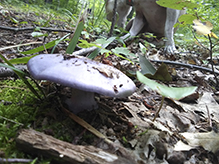 |
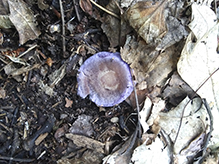 |
|
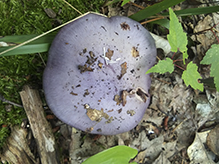 |
||
Chris Storlie |
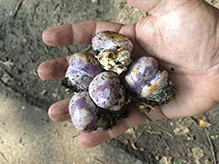 |
Found off a trail on a slight slope on my way to swim at twin lake(behind animal humane society) |
Kristin Threlfall |
||
Found this morning under newly planted perennial. Purple dome just visible to the naked eye. The smaller ones under mulch attached together. |
||
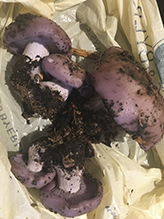 |
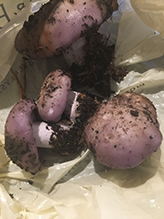 |
|
MinnesotaSeasons.com Photos |
||

Slideshows |
Clitocybe nuda - fungi kingdom |
About
Published on Jan 23, 2015 Clitocybe nuda - fungi kingdom |

Visitor Videos |
||
Share your video of this fungus. |
||
This button not working for you? |
||
|
Other Videos |
||
Meet the beautiful wood blewit (Clitocybe nuda) |
About
Published on Nov 25, 2014 Edulis forager Lisa C finds and introduces you to some handsome wood blewits (Clitocybe/Lepista nuda) for your viewing pleasure. Wood blewits are a stunning lilac colour all over, have a whitish/pale spore print and a characteristic, perfumed aroma. If you find one, look around because they often grow in arcs or rings. They are edible when cooked well and we think they're really tasty! Blewits are saprophytes, living and feeding on decaying organic matter. These chaps join the forager's find list towards the end of autumn into the beginning of winter, and so are a welcome late-season treat when other choice edibles are declining with the drop in temperature and hours of daylight and the arrival of the first frosts. You might also come across other edible blewit varieties such as the field blewit (Clitocybe/Lepista saeva) found in grassland with its bright lilac stem and browny-lilac cap, and the slender version of the wood blewit (Clitocybe/Lepista sordida) which has a much slimmer stem and a smaller, thinner, less substantial cap when compared with C. nuda, often found in close-knit clusters. The featured wood blewits were found on 1 November 2014 in Leeds, UK. At Edulis we're passionate about sustainable foraging - we never take more than we can eat within a few days and we always leave plenty behind (we never take everything). Happy foraging! :) Important safety information: 1. *Never* eat any mushroom (or anything) if you are not 100% sure of its identity for yourself – “if in doubt, throw it out” 2. Never eat anything based solely on an ID suggestion from a video, forum post or any other online source – always do your own research too, study, learn and be 100% sure of the ID. 3. Always check every individual specimen in your collection – an imposter can slip into even the most experienced forager's basket if you're not paying attention... as poisonous/inedible lookalikes often grow with or in similar habitats to the real deal edible species you thought you had picked. With picking blewits, beware of other lilac/purple fungi - for example, to name but a few: Some purple mushrooms can be very poisonous - so before you go picking 'blewits' please familiarise yourself with the superficially visually-similar lookalikes and learn how to tell them apart and keep yourself safe. |
Blewit, Clitocybe nuda, no bruising |
About
Published on Nov 5, 2013 |
Wood Blewit |
About
Uploaded on Nov 4, 2009 Clitocybe Nuda. A very delicious mushroom that must be cooked thoroughly |
Wood Blewit and King Bolete Mushroom Hunting |
About
Uploaded on Oct 7, 2010 More mushrooms: http://www.youtube.com/playlist?list=PL122A6E3339A70090 Thanks for your support! Harvesting a few Blewit, Gem studded puffball and King bolete mushrooms |
Wood Blewits Field Blewits and Clouded Agarics. |
About
Published on Oct 30, 2014 Lepista nuda, the wood blewit, Lepista saeva, the field blewit, The Clouded Agaric, Clitocybe nebularis. Gourmet mushrooms, and one for the brave. |

Visitor Sightings |
||
Report a sighting of this fungus. |
||
This button not working for you? |
||
| Luciearl 8/30/2022 |
Location: Fairview Twp, Cass County |
Apricity Apricity |
Location: Martin County, Fairmont, MN |
|
| Chris Storlie 8/24/2020 |
Location: Golden Valley, MN Found off a trail on a slight slope on my way to swim at twin lake(behind animal humane society) |
 |
| Kristin Threlfall 10/9/2018 |
Location: Edina, MN Found this morning under newly planted perennial. Purple dome just visible to the naked eye. The smaller ones under mulch attached together. |
 |
MinnesotaSeasons.com Sightings |
||
|

Created: 10/3/2015 Last Updated: © MinnesotaSeasons.com. All rights reserved. |
